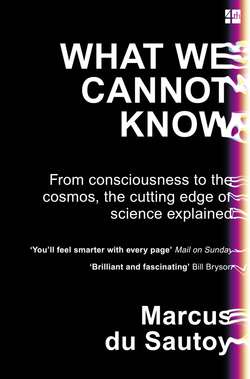Читать книгу What We Cannot Know: Explorations at the Edge of Knowledge - Marcus Sautoy du - Страница 36
INFINITE COMPLEXITY
ОглавлениеWhat of my chances to predict the throw of the dice that sits next to me? Laplace would have said that, provided I can know the dimensions of the dice, the distribution of the atoms, the speed at which it is launched, its relationship to its surrounding environment, theoretically the calculation of its resting point is possible.
The discoveries of Poincaré and those who followed have revealed that just a few decimal places could be the difference between the dice landing on a 6 or a 2. The dice is designed to have only six different outcomes, yet the input data ranges over a potentially continuous spectrum of values. So there are clearly going to be points where a very small change will flip the dice from landing on a 6 to a 2. But what is the nature of those transitions?
Computer models can produce very good visual representations that give me a handle on the sensitivity of various systems to the starting conditions. Next to my Vegas dice I’ve got a classic desktop toy that I can play with for hours. It consists of a metal pendulum that is attracted to three magnets, coloured white, black and grey. Analysis of the dynamics of this toy has led to a picture that captures the ultimate outcome of the pendulum as it starts over each point in the square base of the toy. Colour a point white if starting the pendulum at this point results in it ending at the white magnet. Similarly, colour the point grey or black if the ultimate destination is grey or black. This is the picture you get:
As in the case of population dynamics, there are regions which are entirely predictable. Start close to a magnet and the pendulum will just be attracted to that magnet. But towards the edges of the picture I find myself in far less predictable terrain. Indeed, the picture is now an example of a fractal.
There are regions where there isn’t a simple transition from black to white. If I keep zooming in, the picture never becomes just a region filled with one colour. There is complexity at all scales.
A one-dimensional example of such a picture can be cooked up as follows. Draw a line of unit length and begin by colouring one half black and the other white. Then take half the line from the point 0.25 to 0.75 and flip it over. Now take the half in between that and flip it over again. If we keep doing this to infinity then the predicted behaviour around the point at 0.5 is extremely sensitive to small changes. There is no region containing the point 0.5 which has a single colour.
There is a more elaborate version of this picture. Start again with a line of unit length. Now rub out the middle third of the line. You are left with two black lines with a white space in between. Now rub out the middle third of each of the two black lines. Now we have a black line of length 1⁄9, a white line of length 1⁄9, a black line of length 1⁄9, then the white line of length 1⁄3 that was rubbed out on the first round, and then a repeat of black–white–black.
You may have guessed what I am going to do next. Each time rub out the middle third of all the black lines that you see. Do this to infinity. The resulting picture is called the Cantor set, after the German mathematician Georg Cantor, whom we will encounter in the last Edge, when I explore what we can know about infinity. Suppose this Cantor set was actually controlling the outcome of the pendulum in my desktop toy. If I move the pendulum along this line, I find that this picture predicts some very complicated behaviour in some regions.
A rather strange calculation shows that the total length of the line that has been rubbed out is 1. But there are still black points left inside: 1⁄4 is a point that is never rubbed out, as is 3⁄10. These black points, however, are not isolated. Take any region round a black point and you will always have infinitely many black and white points inside the region.
What do the dynamics of my dice look like? Are they fractal and hence beyond my knowledge? My initial guess was that the dice would be chaotic. However, recent research has turned up a surprise.
